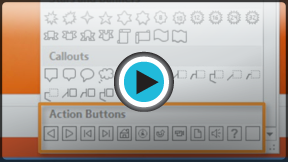Customizing your slide show
Sometimes you might want to hide a slide while still keeping it in your presentation. For instance, if you are presenting a slide show to more than one group of people, hiding or even rearranging certain slides could help you tailor your slide show to each group you present it to. You could also choose to create a shortened version of your slide show to present when you're short on time. The Custom Slide Show feature allows you to create and name different versions of your slide show with hidden or rearranged slides.
To create a custom show:
- Select the Slide Show tab, then locate the Start Slide Show group.
- Click the Custom Slide Show command, then select Custom Shows.

- A dialog box will appear. Click New.
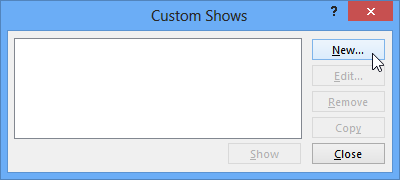
- The Define Custom Show dialog box will appear. Locate the Slide show name field, and type in a name for your custom show.
- In the Slides in presentation: area, check the box next to the slides you want to include in your custom show.
- Click Add to add the slides to the Slides in custom show: box. If necessary, use the up and down arrows to reorder the added slides.
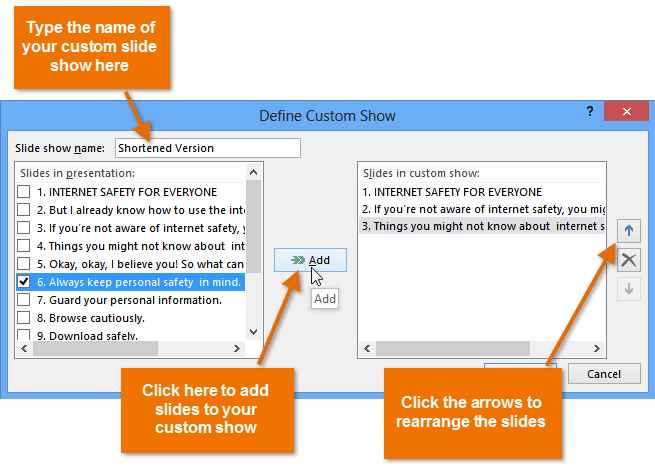
- Click OK.
- Select Close to exit or Show to view your custom show.
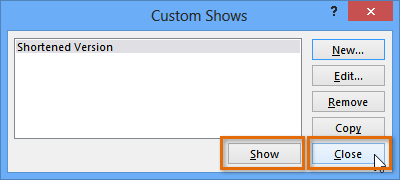
- To play the custom show at any time, click the Custom Slide Show command, then select the desired presentation from the drop-down menu.

Hiding slides
Sometimes you may just need to hide a few slides without rearranging the entire slide show. You can hide slides by selecting the desired slide and then clicking the Hide Slide command on the Slide Show tab. To unhide a slide, simply click the Hide Slide command again.

About hyperlinks
Hyperlinks have two basic parts: the address of the webpage, email address, or other location they are linking to, and the display text (which can also be a picture or shape). For example, the address could be https://www.youtube.com, and YouTube could be the display text. In some cases, the display text might be the same as the address. When you're creating a hyperlink in PowerPoint, you'll be able to choose both the address and the display text or image.
To insert a hyperlink:
- Select the image or text you want to make a hyperlink.
- Right-click the selected text or image, then click Hyperlink.
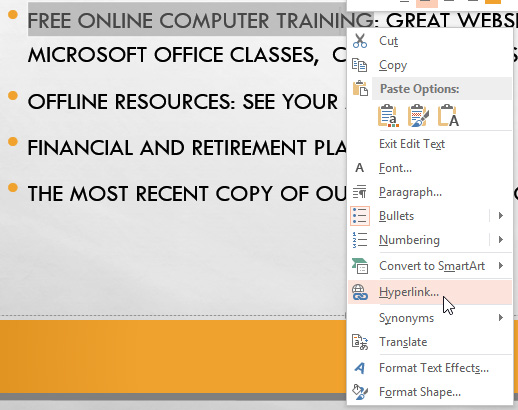
- The Insert Hyperlink dialog box will open. You can also get to this dialog box from the Insert tab by clicking Hyperlink.
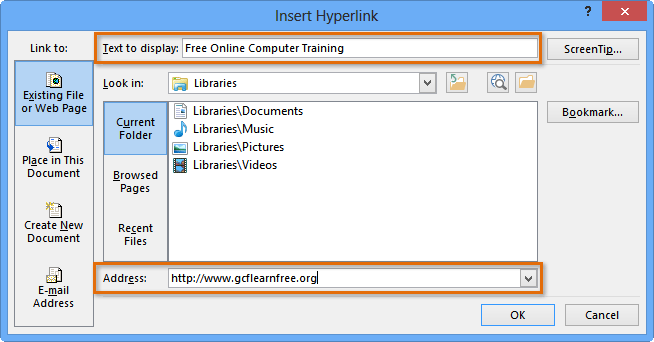
- If you selected text, the words will appear in the Text to display field at the top. You can change this text if you want.
- Type the address you want to link to in the Address field.
- Click OK. The text or image you selected will now be a hyperlink to the web address.

To insert a hyperlink to an email address:
- Right-click the selected text or image, then click Hyperlink.
- The Insert Hyperlink dialog box will open.
- On the left side of the dialog box, click Email Address.
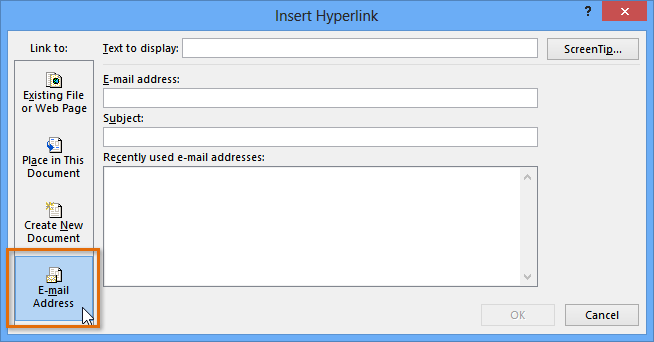
- Type the email address you want to connect to in the Email Address box, then click OK.
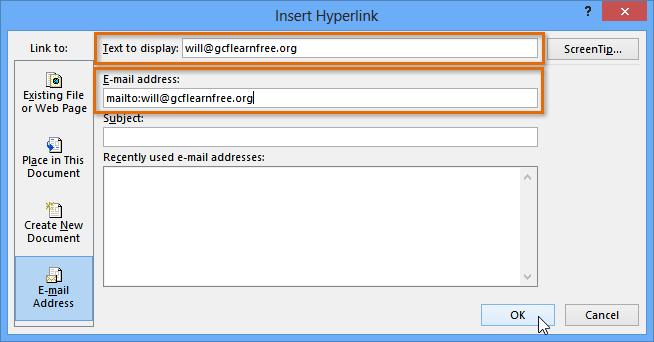
PowerPoint often recognizes email and web addresses as you type and will format them as hyperlinks automatically after you press the Enter key or spacebar.
To open and test a hyperlink
- After you create a hyperlink, you should test it. Right-click the hyperlink, then click Open Hyperlink.
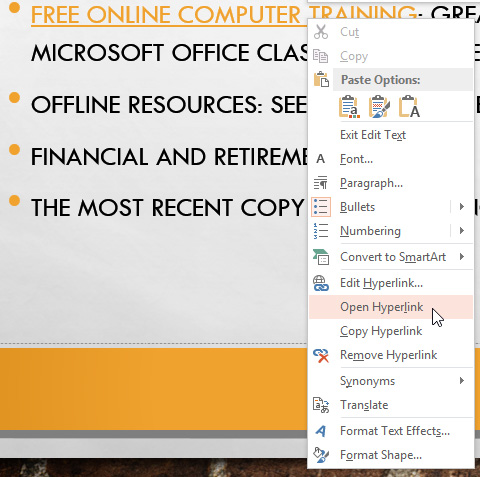
- Your web browser should open and then navigate to the linked page. If it does not work, check the hyperlink address for any misspellings.
To open a hyperlink while viewing your slide show, click the hyperlink.

To remove a hyperlink:
- Right-click the hyperlink.
- Click Remove Hyperlink.
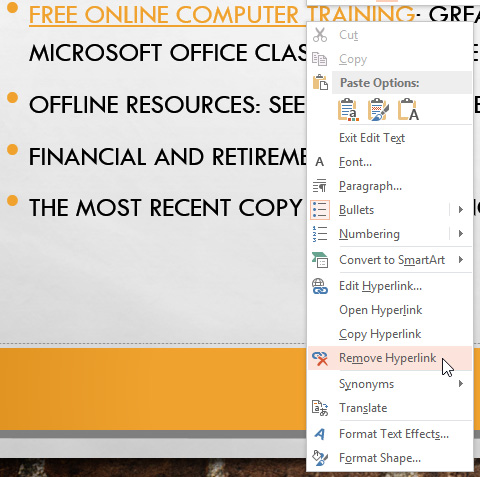
More hyperlinks
In PowerPoint, you can use hyperlinks to link to resources that are not online. To create a quick way to refer to another slide in your presentation, you can create a hyperlink to that slide. If you need to access a file stored on your computer, you can create a hyperlink to it. Additionally, PowerPoint allows you to format pictures and shapes as hyperlinks.
To insert a hyperlink to another slide:
- Right-click the selected text or image, then click Hyperlink.
- The Insert Hyperlink dialog box will appear.
- On the left side of the dialog box, click Place in this Document.
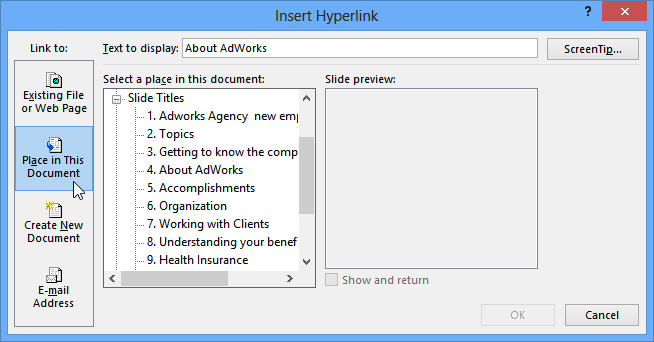
- A list of the other slides in your presentation will appear. Click the name of the slide you want to link to.

- Click OK. The text or image will now be a hyperlink to the slide you selected.

To insert a hyperlink to another file:
- Right-click the selected text or image, then click Hyperlink. The Insert Hyperlink dialog box will appear.
- On the left side of the dialog box, click Existing File or Webpage.
- Click the drop-down arrow to browse for your file.
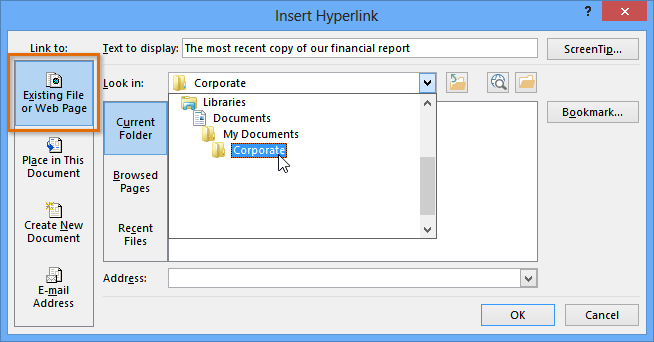
- Select the desired file.
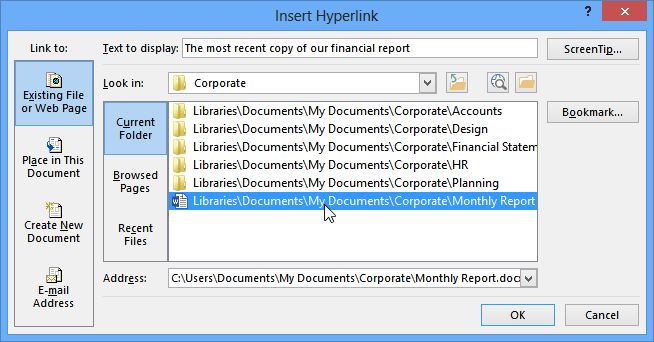
- Click OK. The text or image will now be a hyperlink to the file you selected.

If you plan on displaying your presentation on a different computer than you used to create it, your hyperlink to another file may not work. Make sure you have a copy of the linked file on the computer you are using to present, and always test hyperlinks before giving a presentation.
Using shapes and pictures as hyperlinks
Sometimes you might want to to format objects—including shapes, text boxes, and pictures—as hyperlinks. This is especially helpful if you want the object to act like a button. To do this, right-click the desired object and select Hyperlink from the menu that appears. Click the object during the presentation to open the hyperlink.
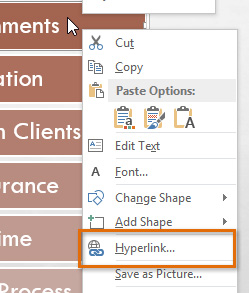
Inserting action buttons
Another tool you can use to connect to a webpage, file, email address, or slide is called an action button. Action buttons are built-in button shapes you can add to a presentation and set to link to another slide, play a sound, or perform a similar action. When someone clicks or moves over the button, the selected action will occur. Action buttons can do many of the same things as hyperlinks. Their easy-to-understand style makes them especially useful for self-running presentations at booths and kiosks.
You can insert action buttons on one slide at a time, or you can insert an action button that will show up on every slide. The second option can be useful if you want every slide to link back to a specific slide, like the title page or table of contents.
To insert an action button on one slide:
- Click the Insert tab.
- Click the Shapes command in the Illustrations group. A drop-down menu will appear with the action buttons located at the very bottom.
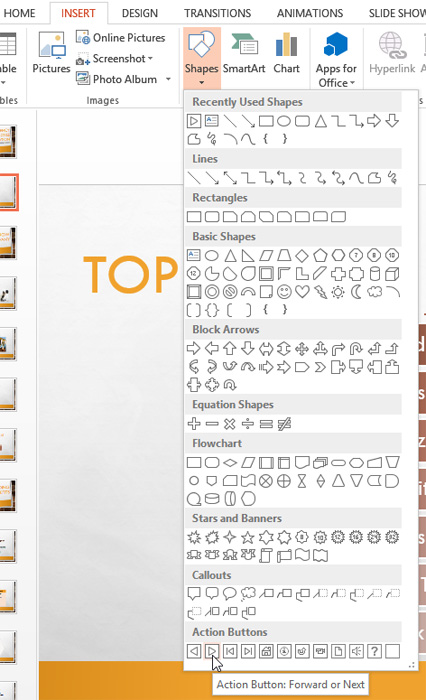
- Select the desired action button.
- Insert the button onto the slide by clicking the desired location. The Action Settings dialog box will appear.
- Select the Mouse Click or Mouse Over tab. Selecting the Mouse Click tab means the action button will perform its action only when clicked. Selecting the Mouse Over tab will make the action button perform its action when you move the mouse over it.
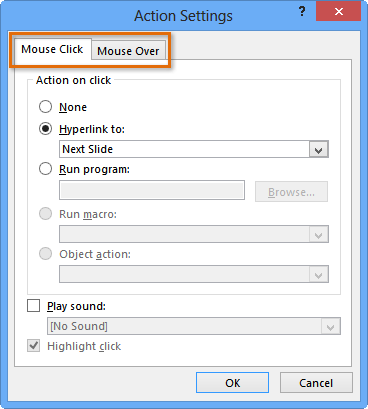
- In the Action on click section, select Hyperlink to: then click the drop-down arrow and choose an option from the menu.
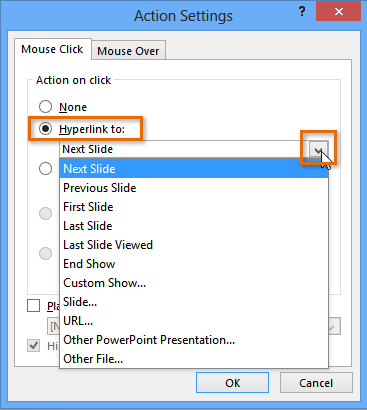
- Check the Play Sound box if you want a sound to play when the action button is clicked. Select a sound from the drop-down menu, or select Other sound to use a sound file on your computer.
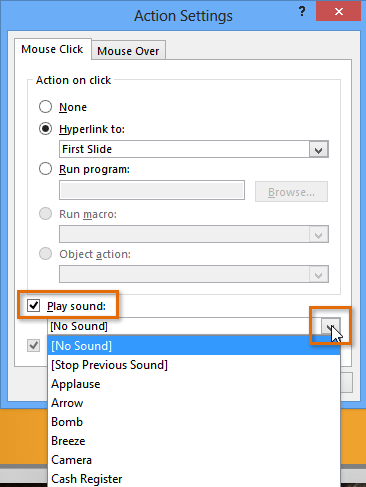
- Click OK.

To insert an action button on all slides:
- Click the View tab.
- In the Master Views group, click the Slide Master command. A blank slide in the style of your presentation will appear. Don't worry about changing anything else.
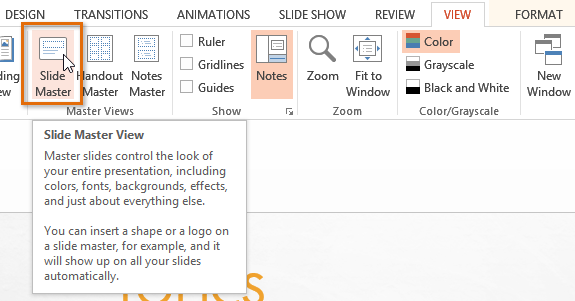
- Go to the Insert tab, and follow the instructions above to insert an action button.
- Return to the Slide Master tab, and click Close Master View. The new action button will now be on every slide.

To edit, move, or delete an action button inserted this way, click the View tab, then Slide Master. Click Close Master View after making the desired changes.
To test an action button:
After you create an action button, you should test it.
- Click the Slide Show tab.
- In the Start Slide Show group, click From Current Slide.

- Click your action button.
- After you have tested it, right-click anywhere on the screen and select End Show.
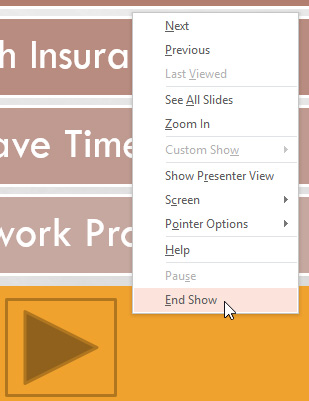
- If your action button did not work as you intended, follow the instructions below to edit it.
To edit an action button:
- Select the action button.
- Click the Insert tab.
- In the Links group, click the Action command. The Actions Settings dialog box will appear.
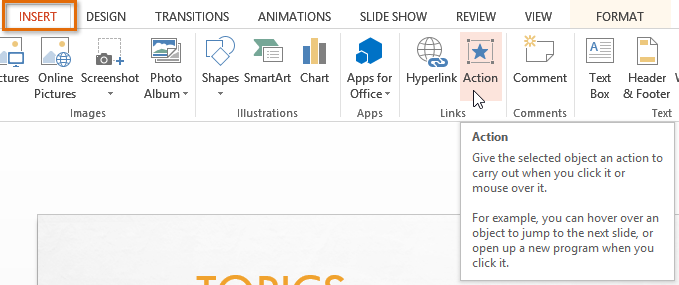
- Edit the action or hyperlink.
- Click OK.
To change the appearance of an action button:
- Select the action button.
- Click the Format tab.

- To change the button style or color, use the tools in the Shape Styles group.
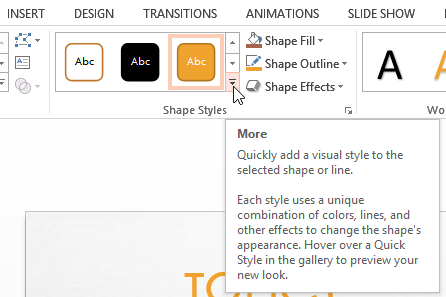
- To change the shape of the action button, click Edit Shape in the Insert Shapes group. Select a new shape from the drop-down menu.
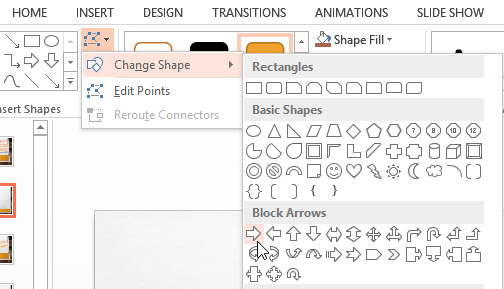
References: https://www.gcflearnfree.org/powerpoint2013/hyperlinks-and-action-buttons/1/
: https://www.gcflearnfree.org/powerpoint2013/advanced-presentation-options/1/
As future educator, it important to use different of instructional materials in your discussion, one of the useful instructional materials used today is PowerPoint Presentation. PowerPoint Presentation is very accessible and easy to used. It is very helpful for teachers and also it will capture the attention of your students. In this blog, you can get an idea on how to used hyperlinks, custom shows and action button that makes your presentation more useful and easy to operate during your instruction.
Here are some pictures of my PPT using hyperlinks, Custom shows and Action Button:
I hope you guys learn something about this blog. Thank You !!
